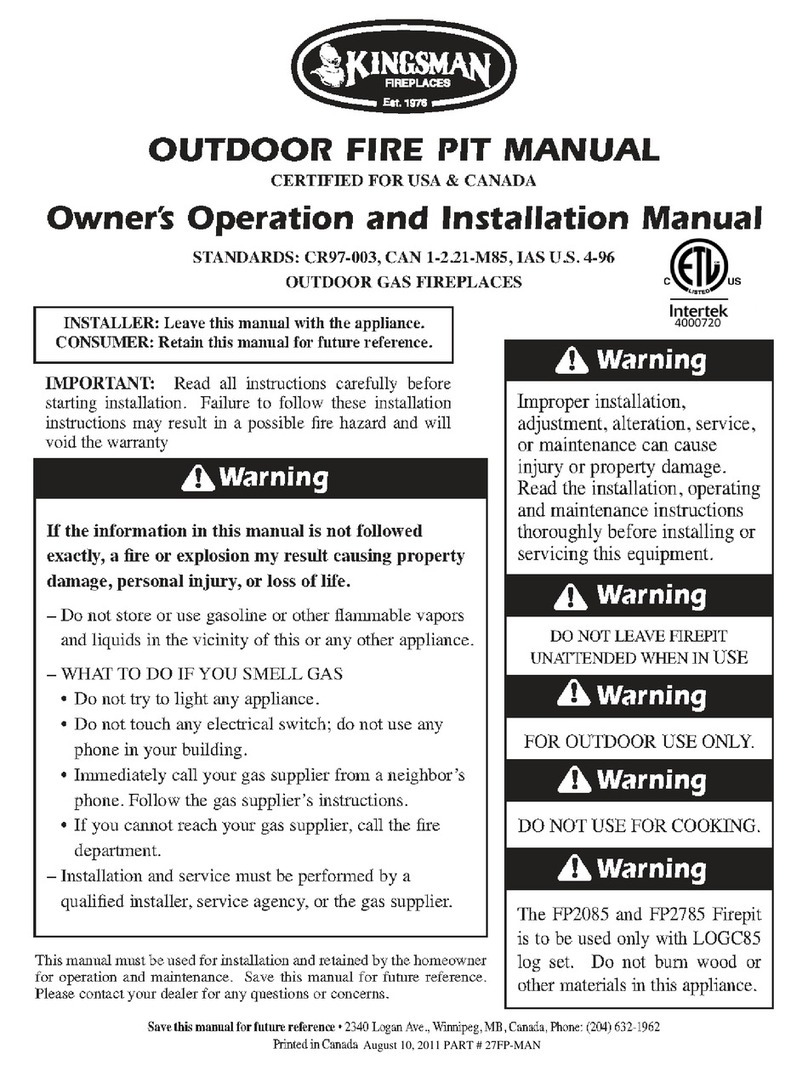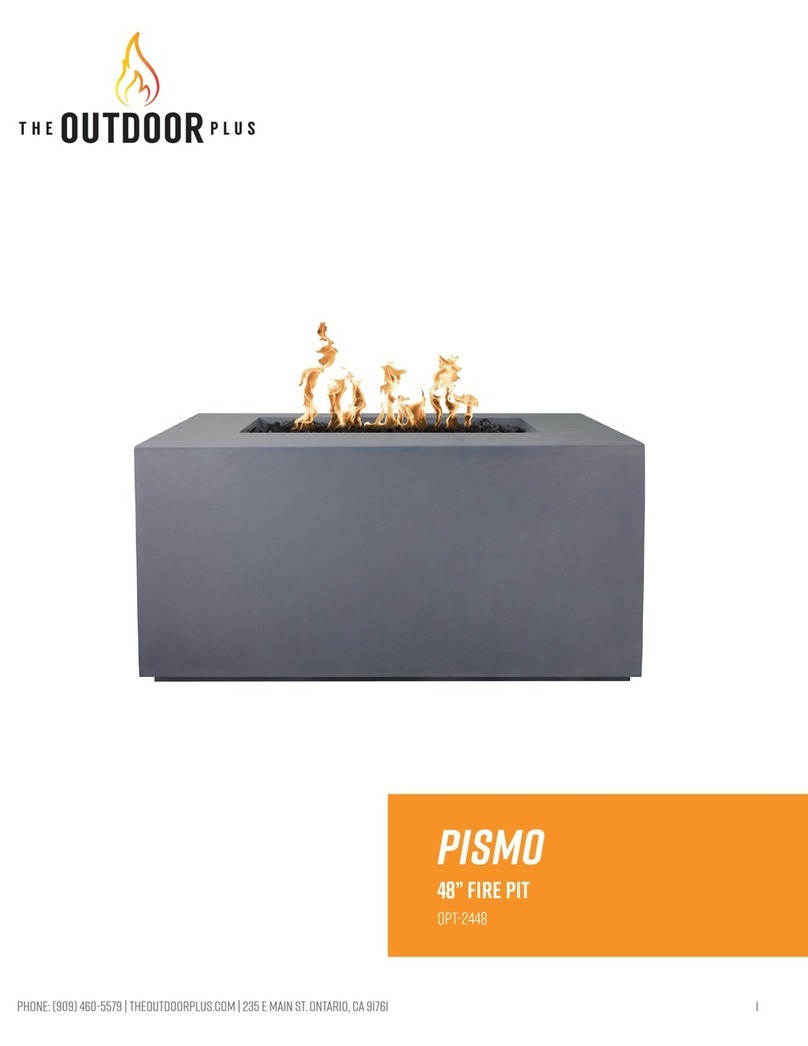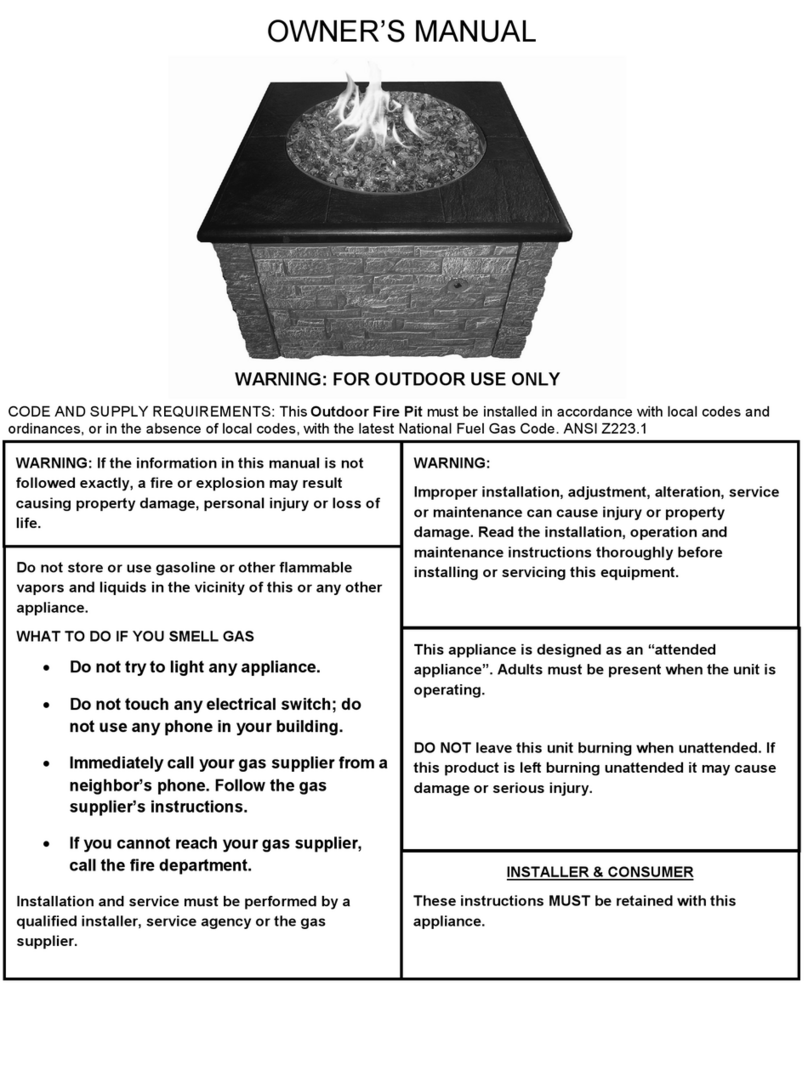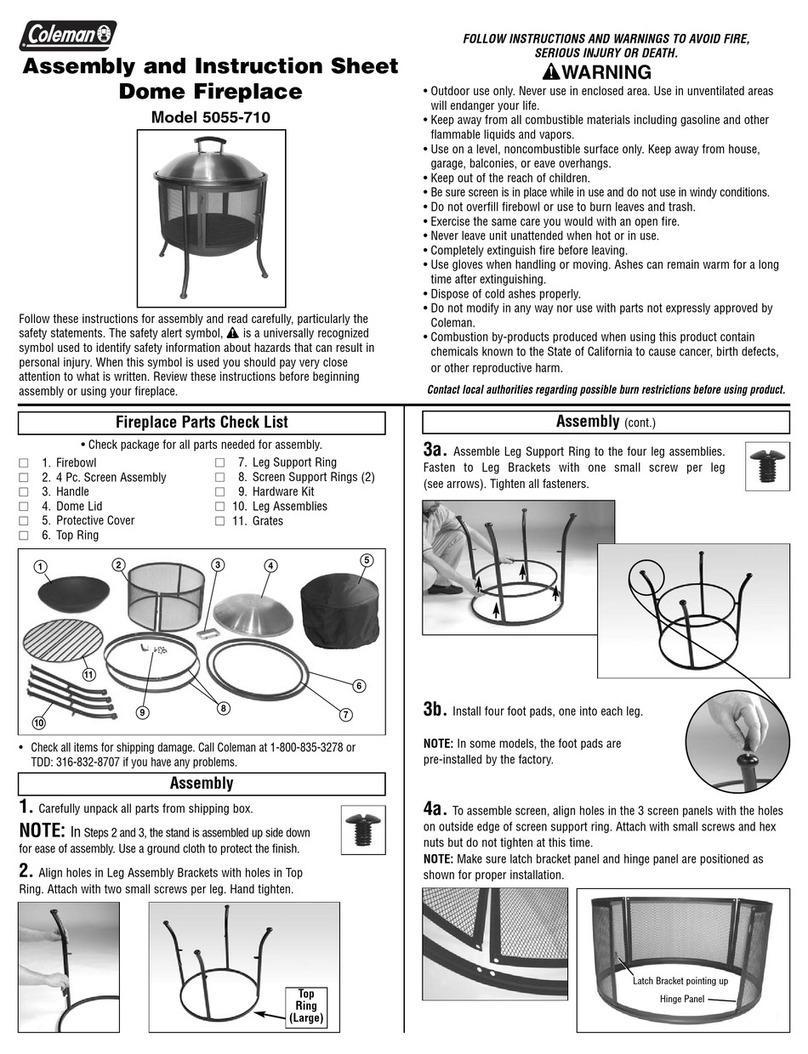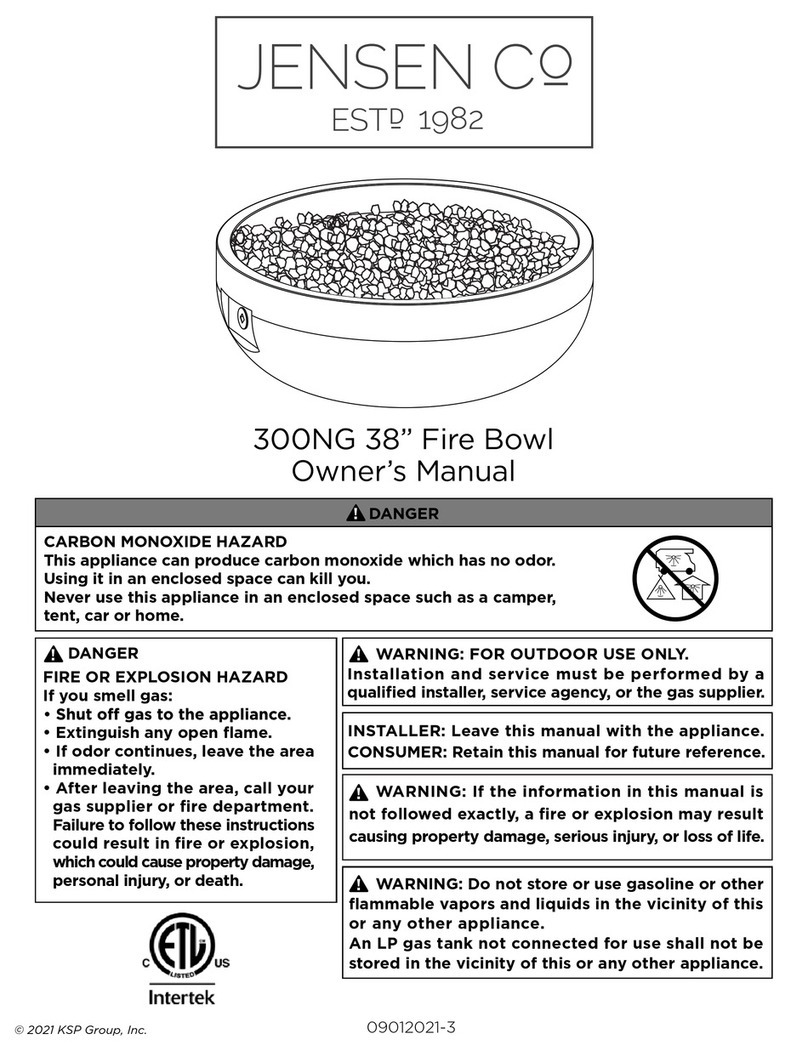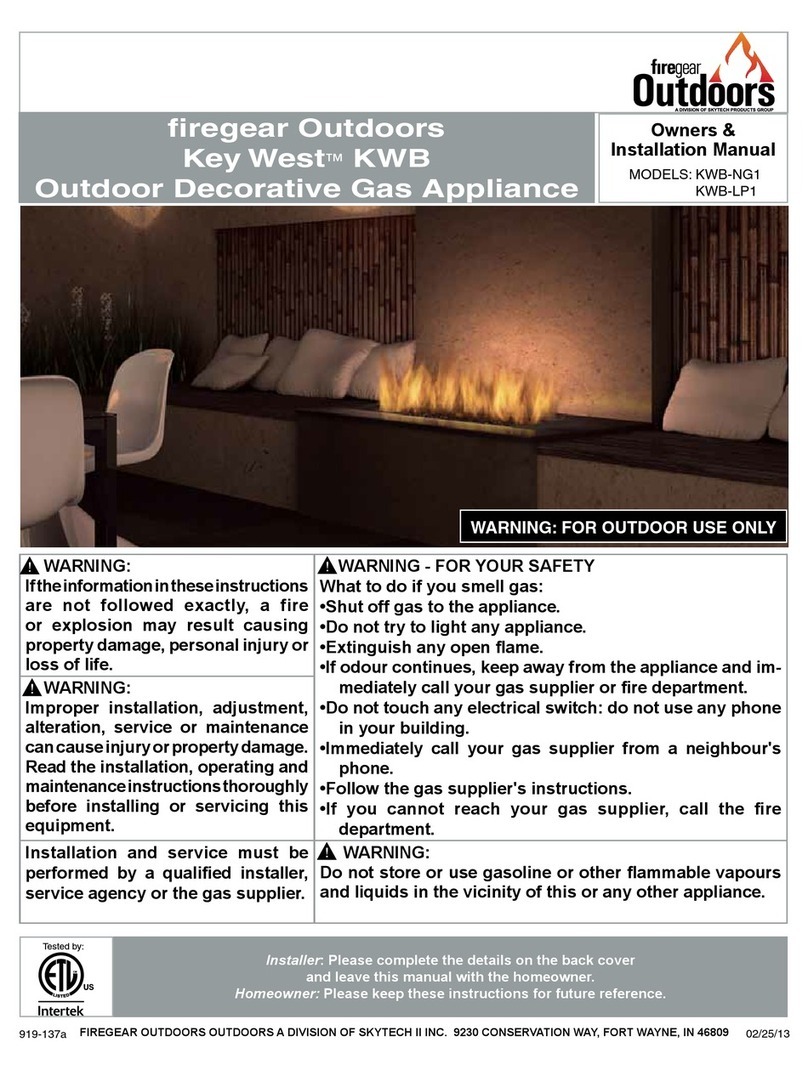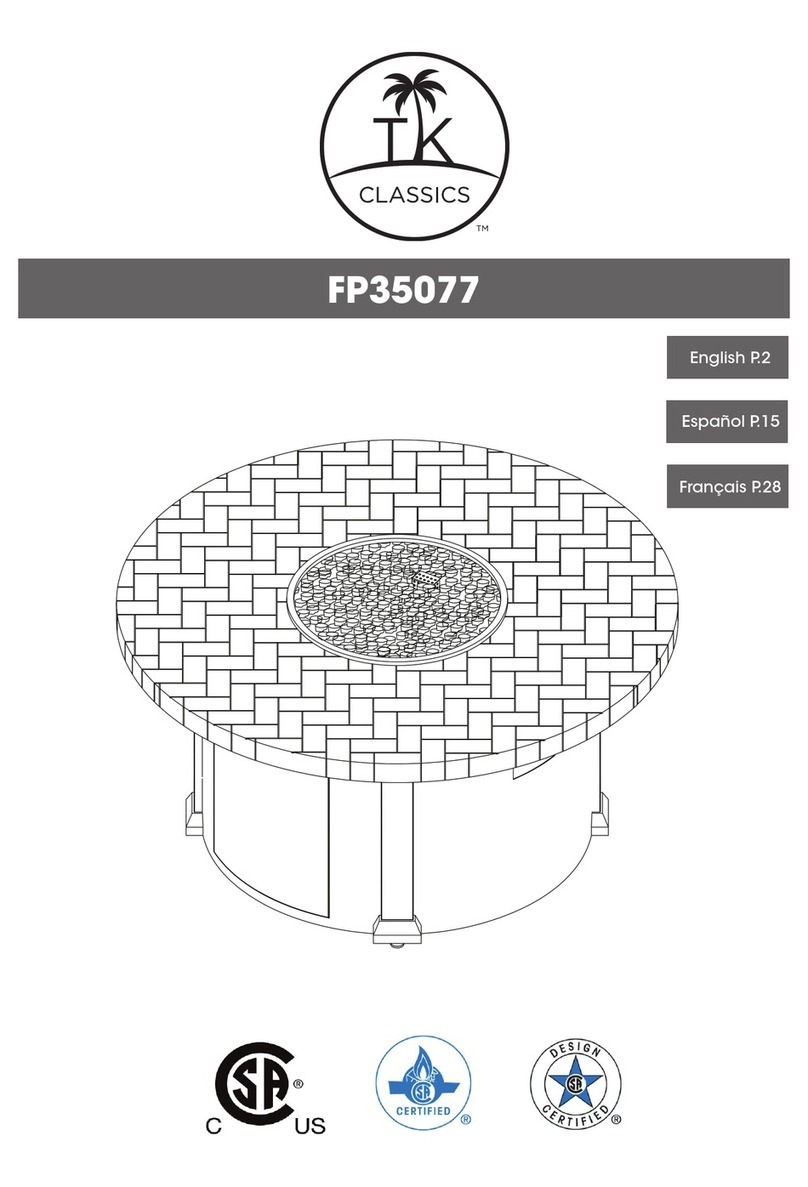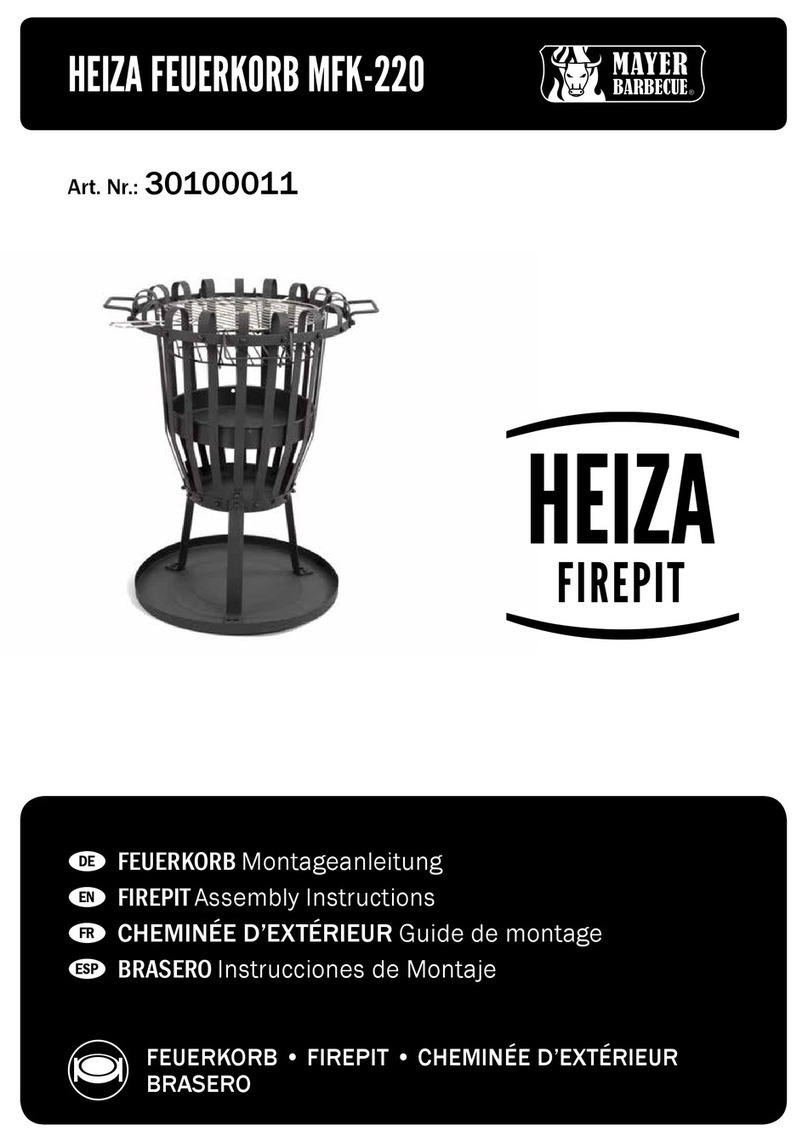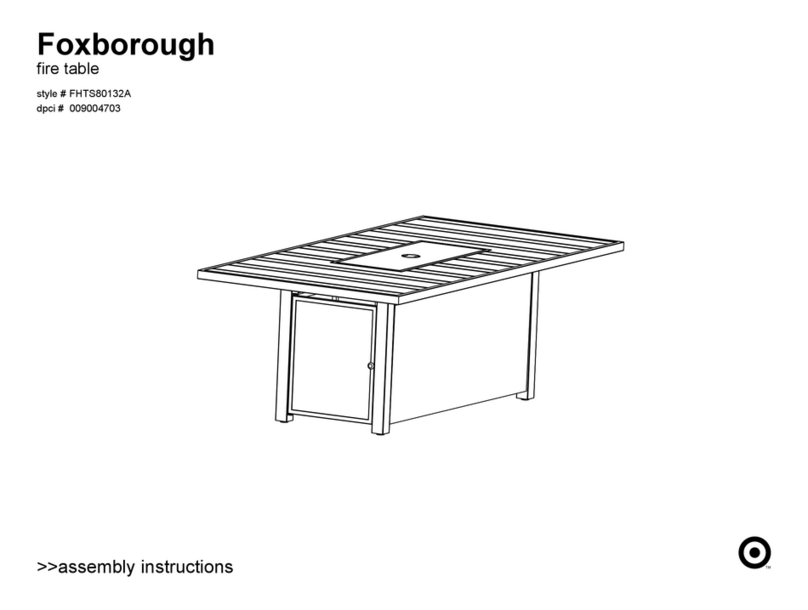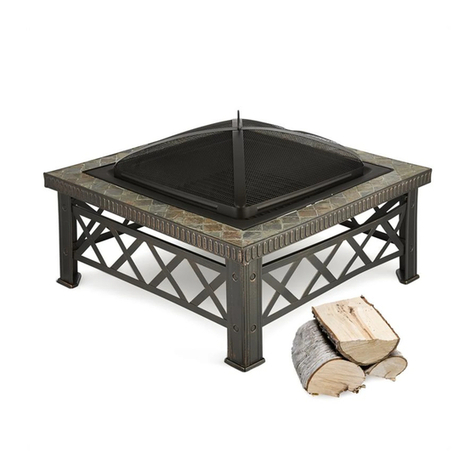Crosley Furniture CO9011 User manual

Fire Table
CO9011
INSTRUCTION MANUAL

TABLE OF CONTENTS
2
Warnings and Cautions ...........................................................3-5
•
•Parts List .................................................................................6-7
•Assembly ..............................................................................8-11
• Operation .............................................................................12-14
•Maintenance and Storage ...................................................15-16
•Troubleshooting .......................................................................17
REMINDER
BEFORE ASSEMBLY
Verify that all parts are included with your appliance BEFORE you begin assembly by
checking the Parts and Hardware List. For your convenience, some parts may be pre-
assembled.
If some parts are not included, do not attempt to assemble appliance. Call the free number on
the cover page for replacement parts.
Please do not fully tighten bolts until appliance is fully assembled.
OWNER’S MANUAL
Keep and store this Owner’s Manual for future reference. It contains important instructions
and procedures for safety and maintenance.

CAUTION
Installer: Leave this manual with the
appliance.
Consumer: Retain this manual for future
reference.
Safety Information
Read the instruction before use. This appliance must be installed in accordance with such
regulations as are enforced.
WARNING: For Outdoor Use Only!
DANGER:
3
FIRE OR EXPLOSION HAZARD
If you smell gas:
•Shut off gas to the appliance.
•Extinguish any open flame.
•If odor continues, leave the area
immediately.
•After leaving the area, call your gas
supplier or fire department.
Failure to follow these instructions could
result in fire or explosion, which could
cause property damage, personal injury,
or death.
Installation and service must be performed
by a qualified installer, service agency, or the
gas supplier.
WARNING:
Improper installation, adjustment alteration,
service or maintenance can cause property
damage, personal injury, or loss of life. Read
the installation, operating, and maintenance
instructions thoroughly before installing or
servicing this gas appliance.
WARNING:
FOR YOUR SAFETY:
If the information in this manual is not
followed exactly, a fire or explosion may
result causing property damage, personal
injury or loss of life.
WHAT TO DO IF YOU SMELL GAS:
Do not try lighting any appliance.
Do not touch any electrical switch; DO NOT
use any phone in your building.
Immediately call your gas supplier from a
neighbor’s phone.
Follow the gas supplier’s instructions.
If you cannot reach your gas supplier.
Call the fire department.
Installation and service must be performed
by a qualified installer, service agency or gas
supplier. Save these instructions for future
reference. If you are assembling this unit for
someone else, give this manual to him or her
to read and save for future reference.
DANGER CARBON MONOXIDE
HAZARD
This appliance can
produce carbon
monoxide which has no
odor.
Using it in an enclosed
space can kill you.
Never use this
appliance in an
enclosed space such
as a camper, tent, car
or home.
WARNING: Do not store or use
INSTALLER: leave this manual with the
appliance.
CONSUMER: Retain this manual for
future reference.
gasoline, or other flammable vapors and
liquids, in the vicinity of this or any other
appliance. An Lp-cylinder not connected for
use shall not be stored in the vicinity of this
or any other appliance.

You must provide propane gas and propane cylinder. Use a standard 20 lb. propane
cylinder only.
Use this heater only with a propane vapor withdrawal supply system. See Chapter 5 of
the Standard for Storage and Handling of Liquefied Petroleum Gas, ANS/NFPA 58. Your
local library or fire department should have this book.
The pressure regulator and hose assembly supplied with the appliance must be used.
The installation must conform with local codes, or in absence of local codes, with National
Fuel Gas Code, ANSI Z223.1.
A dented, rusted, or damaged propane cylinder may be hazardous and should be checked
by your cylinder supplier. Never use a propane cylinder with a damaged valve connection.
The LP-gas supply cylinder must be constructed and marked in accordance with the
U.S. Department of Transportation (D.O.T) Specifications for LP-Gas Cylinders, or the
standard for Cylinders, Spheres and Tubes for Transportation of Dangerous Good and
Commission, CAN/CSA-B339, as applicable.
The LP-gas supply cylinder must be provided with a cylinder connection device
compatible with the connection for the appliance.
The cylinder used must include a collar to protect
the cylinder valve.
The LP-gas supply cylinder must be provided
with a listed overfill protection device (OPD).
Do not store a spare LP gas cylinder under or
near this appliance.
Never fill the cylinder beyond 80 percent full.
For appliances designed to use a CGA No.
791IQCC connection.
Place the dust cap on the cylinder valve outlet
whenever the cylinder is not in use.
Note: Gas supply pressure: 25 PSI to 250 PSI.
4
WARNING: FUELS USED IN LIQUIFIED PROPANE GAS APPLIANCES, AND THE
PRODUCTS OF COMBUSTION OF SUCH FUELS, CAN EXPOSE YOU TO
CHEMICALS INCLUDING BENZENE, WHICH IS KNOWN TO THE STATE OF
CALIFORNIA TO CAUSE CANCER AND CAUSE BIRTH DEFECTS OR OTHER
REPRODUCTIVE HARM. For more information go to: www.P65Warnings.ca.gov.
Standard 20 lbs. tank

WARNING S
PLEASE READ THE FOLLOWING SAFETY RULES
WARNING:
The appliance is not for use with solid fuel.
The installation must conform with local
codes or, in the absence of local codes, with
the National Fuel Gas Code, ANSI Z223. 1/
NFPA 54, NFPA58 Natural Gas and
Propane Installation Code, CSA B149.1, or
Propane Storage and Handling CODE,
B149.2.
The appliance, when installed, must be
electrically grounded in accordance with
local codes or, in the absence of local codes,
with the National Electrical Code, ANSI/
NFPA 70, or the Canadian Electrical Code,
CSA C22.1.
Prior to use, check for damaged parts such
as hose, regulators, pilot or burner.
Inspect the fuel supply connection for signs
of leakage (including the hose for LP
models) before each use of the appliance.
All leak tests should be done with a soapy
solution. NEVER USE AN OPEN FLAME TO
CHECK FOR LEAKAGE.
Children and adults should be alerted
to the hazards of high surface
temperatures and should stay away to
avoid burns or clothing ignition.
Young children should be carefully
supervised when they are in the area of the
appliance.
Clothing or other flammable materials should
not be hung from the appliance, or placed on
or near the appliance.
Any guard or other protective device
removed for servicing the appliance must
be replaced prior to operating the
appliance.
Installation and repair should be done by
a qualified service person. The appliance
should be inspected before use and at
least annually by a qualified service
person.
More frequent cleaning may be required
as necessary. It is imperative that control
compartment, burners and circulating air
passageways of the appliance be kept
clean.
Keep the appliance area clear and free
from combustible materials, gasoline and
other flammable vapors and liquids.
DO NOT OBSTRUCT the flow of
combustion and ventilation air.
Keep the ventilation opening(s) of the
cylinder enclosure free and clear from
debris.
The appliance shall be used only in a
well-ventilated space and shall not be
used in a building, garage or any other
enclosed area.
An appliance may be installed with
shelter no more inclusive than: With
walls on all sides, but with no
overhead cover.
Within a partial enclosure which includes
an overhead cover and no more than two
side walls. These side walls may be
parallel, as in a breezeway, or at
right angles to each other.
5

6
PARTS LIST
B
C
D
D
D
H
I
J
K
E
G
L
L
M
A
F

M 6 x10 mm
21 PCS (Extra 1)
7
HARDWARE LIST
ABCDE
Lid
1 PC
Top Panel
1 PC
Side Panel
3 PCS
Flame Glass
(6kgs)
1 PC
FGHIJ
Knob
1 PC
Door Panel
1 PC
Right Leg
1 PC
Left Leg
1 PC
Left Door Leg
1 PC
Right Door Leg
1 PC
KL M
Propane Tank
Support
1 PC
Table Cover
1 PC
Cylinder Cover
1 PC
ADDITIONAL TOOLS (Not Provided)
Note: It is not recommended to use power tools during assembly.
Phillips Head Screwdriver
#1
Bolt
(With Burner)
PART LIST

below. Attach right leg (part G), left leg (part H), left door leg (part I), right door leg
(part J) using bolts (part #1) and phillips head screwdriver.
NOTE: Please do not fully tighten bolts until appliance is fully assembled.
Step 2. Attach side panels (part D) to right leg (part G), left leg (part H), left door leg (part I),
right door leg (part J) using bolts (part #1) and phillips head screwdriver.
NOTE: Please do not fully tighten bolts until appliance is fully assembled.
8
G
J
I
H
C
#1
#1 x 4
#1
J
GH
I
DD
D
#1 x 12
Step 1. Lay top panel (part C) upside down on a soft flat surface, such as carpet, as shown
ASSEMBLY

leg (part I), right door leg (part J) using bolts (part #1) and phillips head screwdriver.
NOTE: Please fully tighten all bolts at this time.
9
#1
H
G
J
I
K
Step 4. Attach knob (part F) to door panel (part E) using bolt (part #1) and phillips head
screwdriver.
NOTE: Please fully tighten all bolts at this time.
#1
#1 x 4
#1 x 1
F
E
Step 3. Attach propane tank support (part K) to right leg (part G), left leg (part H), left door

Step 6.
Put the flame glass (part B) into the fire bowl. Ensure flame glass (part B) is not
covering pilot housing, as shown below. Place lid (part A) over fire bowl. The lid
(part A) must be removed when burner is in use. Wait until the appliance cools
before placing lid (part A) over fire bowl.
NOTE: Do not dump flame glass (part B) out of package. Carefully place flame glass
(part B) by hand to prevent dust from clogging burning.
10
A
B
I
E
Step 5. Carefully turn appliance upright. Line up the pins on the hinges from door panel (part E)
with the holes in the hinges from left door leg (part I) and slide them together as shown
below.

support (part K) and secure the cylinder by tightening the screw in the
propane tank support (part K). Connect the hose of regulator to the cylinder.
NOTE: The propane cylinder is sold separately. Use a standard 20lb. propane
cylinder only.
Step 8. Open the igniter and place AAA battery (not included) into the igniter and tighten
clockwise. Now the appliance is ready to use.
When the appliance has cooled down COMPLETELY and NOT in use, put table cover
(part L) on the appliance.
NOTE: Remove plastic wrap before installing battery.
M
K
11
Step 7. Put cylinder cover (part M) on the cylinder. Put the cylinder into the propane tank

12
OPERATION
WARNING: Never use this appliance for other than the intended use. Do not use this
appliance to prepare food.
Initial Lighting: When lit for the first time, the appliance emits a slight odor. This is normal
temporary condition caused by the “burn –in” of internal paints and lubricants used in the
manufacturing process and does not occur again. Simply run the main burner on high for
approximately one-half hour.
WARNING:
•Children and adults should be alerted to the hazards of high surface temperatures
and should stay away from the appliance to avoid burns or clothing ignition.
•Children should be carefully supervised when they are in the area of the appliance.
•Clothing or other flammable materials should not be hung from the appliance, or placed
on or near the appliance. The area above the enclosure may be extremely
hot. Direct contact with these surfaces should be avoided in order to prevent burns
or clothing ignition.
•Any guard or protective device removed for servicing the appliance must be replaced prior
to operating the appliance.
•Installation and repair should be done by a qualified service person.
•The appliance should be inspected before each use and at least annually by a qualified
service person. More frequent cleaning may be required necessary. It is imperative that the
control compartment, burners and circulating air passageways of the appliance be kept
clean.
WARNING:
•Never use the appliance while it is raining. Always turn the appliance off when raining.
•Never use the appliance if the burner is damaged. Inspect the burner before each use.
•Ensure that no debris such as leaves; grass or other objects have entered or are on the
appliance. If the burner is damaged it must be replaced prior to using the appliance with a
replacement burner specified by your manufacture.
•Inspect the hose assembly before each use. If there is evidence of excessive abrasion
or wear, or if the hose is damaged it must be replaced prior to using the appliance with a
replacement hose assembly specified by your manufacture.
WARNING: Any modification to the appliance may compromise the safety
of this appliance. Special concern is as followed:
Do not bypass thermocouple safety.
Do not operate the appliance if any parts has been under water. Immediately call a
qualified service technician to inspect the appliance and replace any part of the control
system and gas control, that has been underwater.

13
LEAK TESTING OPERATION
WARNING: DO NOT USE AN OPEN FLAME.
LEAK TESTING: This must be done before initial use, annually, and whenever any gas
components are replaced or serviced. Do not smoke while performing this test, and remove
all sources of ignition. See leak testing diagram for areas to check. Turn all burner controls to
the off position. Turn gas supply valve on. Brush a half-and-half solution of liquid soap and
water onto all joints and connections of the regulator, hose, manifolds and valves. Bubbles
will indicate a gas leak. Either tighten the loose joint or have the part replaced with one
recommended by your manufacture and have the appliance inspected by a certified gas
installer.
If the leak cannot be stopped, immediately shut off the gas supply, disconnect it, and have the
appliance inspected by a certified gas installer. Do not use the appliance until the leaks have
been corrected.
WARNING: A leak test must be performed annually or if a part of the gas system is
replaced.
WARNING: Never use an open flame to check for gas leaks. Be certain no sparks
or open flames are in the area while you check for leaks. Sparks or open flames will result
in a fire or explosion, damage to property, serious bodily injury, or death.

Lighting Instructions
1. Press and hold electronic igniter button.
2. Turn the burner control to the low position,
press and hold. When the burner lights, release
the electronic igniter button.
3. Continue to depress the burner control knob for
30 seonds and then release. If the flame goes out,
repeat the procedue.
4. Adjust the flame to the desired height with the
burner control knob. Visually check the burner
flames as pictured below.
5. If the burner will not light with the electronic
igniter, hold a lit long match or lit long butane
lighter to the ignition area of the burner and
continue with step 2.
6. To shut down the burner turn the burner control
knob clockwise to the off position. Then turn the
gas off at the source (propane cylinder valve).
Normal
WARNING
FOR YOUR SAFETY:
Keep face and body away from
burner area when lighting.
Ensure burner controls are in the off
position.
Slowly turn on the gas supply valve.
WARNING
FOR YOUR SAFETY:
The propane cylinder is equipped
with an excess flow device. Unless
burners are turned off prior to turning
the cylinder on, only small flames
and low heat will be achievable.
WARNING
FOR YOUR SAFETY:
The propane cylinder is equipped
with an excess flow device. Unless
burners are turned off prior to turning
the cylinder on, only small flames
and low heat will be achievable.
WARNING
FOR YOUR SAFETY:
Surface of the fire pit can remain
extremely hot for a period after use.
Allow 45 minutes to cool down
before touching or moving the fire pit.
4

15
MAINTENANCE AND STORAGE
MAINTENANCE:
To enjoy years of outstanding performance from your appliance, make sure you
perform the following maintenance activities on a regular basis:
•At least once a year, the unit should be inspected for the presence of
spiders, spider webs or other insects.
• Air flow must be unobstructed. Keep controls, burner, and circulating air
passageways clean. Signs of possible blockage include:
Gas odor with extreme yellow tipping of flame.
Appliance does NOT reach the desired temperature.
Heat glow is excessively uneven.
Heat makes popping noises.
•Spiders and insects can nest in burner or orifices. This dangerous condition can
damage appliance and render it unsafe for use. Clean burner holes by using
a heavy-duty pipe cleaner. Compressed air may help clear away smaller particles.
•Carbon deposits may create a fire hazard. Clean reflector, thermocouple and emitter
screen with a dry cloth if any carbon deposits develop.
•The burner is made from stainless steel, but extreme heat and a corrosive
environment can cause surface corrosion to occur. Inspect the burner at least
annually for cracks, insect nests, excessive corrosion or any other damage. If the
burner is damaged, it must be replaced with a burner specified by the manufacturer
before the appliance is put into operation.

16
During periods of extended inactivity or when transporting
•Turn the control knob to “OFF” position.
•Disconnect LP source and move to a secure, well ventilated location
outdoors. DO NOT store in a location that will exceed 125 degrees F.
•Store appliance upright in an area sheltered from direct contact with
inclement weather (such as rain, sleet, hail, snow, dust and debris).
•Cover appliance to protect exterior surfaces and to help prevent build up in
air passages.
NOTE: Wait until appliance is cool before covering.
STORAGE:
Between uses
•Turn the control knob to “OFF” position.
•Disconnect LP source.
•Store appliance upright in an area sheltered from direct contact with
inclement weather (such as rain, sleet, hail, snow, dust and debris).
•Cover appliance to protect exterior surfaces and to help prevent build up in
air passages.
NOTE: Wait until appliance is cool before covering.

17
TROUBLESHOOTING
PROBLEM PROBABLE CAUSE SOLUTION
Low heat / Low flame
when valve turned to
high.
For propane- improper lighting
procedure.
Ensure lighting procedure is followed carefully. The
valve must be in the off position when the tank valve is
turned on. Turn tank on slowly to allow pressure to
equalize. See lighting instruction.
Pipe must be sized according to installation code.
Burners burn with yellow
flame, accompanied by
the smell of gas.
Possible spider web or other
debris.
Thoroughly clean burner venturi. See general
maintenance instructions.
Burner will not light with
the igniter, but will light
with a match.
Dead battery / or installed
incorrectly.
Loose electrode wire or switch
terminal wires.
Replace with heavy duty battery.
Check that electrode wire is firmly pushed onto the
terminal on the back of the igniter. Check that the lead
wires from the module to the ignition switch ( if equipped)
are firmly pushed onto their respective terminals.
Burner will not stay lit
when control knob is
released.
Knob not being held in long
enough.
Too windy.
Flame glass or debris in
ignition area of the burner
preventing thermocouple from
being fully engulfed in flame.
Dirty thermocouple or
thermocouple connection.
Faulty thermocouple or valve.
Thermocouple mush have time to heat up-hold the knob
in for 30 seconds after the burner lights, then release.
Unit will shut down if winds are greater than 10mph
(16km/h). Either locate to different area or use when it is
less windy.
Ensure there is no flame glass or other debris in ignition
area, and that the small hole below the thermocouple is
unobstructed.
Clean the thermocouple and clean the connection
between the valve and thermocouple. Ensure the
connection is properly tightened.
Replace thermocouple and / or valve.
Humming regulator. Normal occurrence on hot days. This is not a defect. It is caused by internal vibrations in
the regulator and does not affect the performance or
safety of the appliance.
Humming regulators will not be replaced.
Burner output on “high”
setting is too low.
(Rumbling noise and
fluttering blue flame at
burner surface.)
Lack of gas.
Supply hose is pinched.
Dirty or clogged orifice.
Spider webs or other matter in
venturi tube.
Propane regulator in “low flow”
state.
Check gas level in propane cylinder.
Reposition supply hose as necessary.
Clean burner orifice.
Clean out venturi tube.
Ensure lighting procedure is followed carefully. All
valves must be in the off position when the tank valve is
turned on. Turn tank on slowly to allow pressure to
equalize. See lighting instructions.
Table of contents
Other Crosley Furniture Outdoor Fireplace manuals
Popular Outdoor Fireplace manuals by other brands
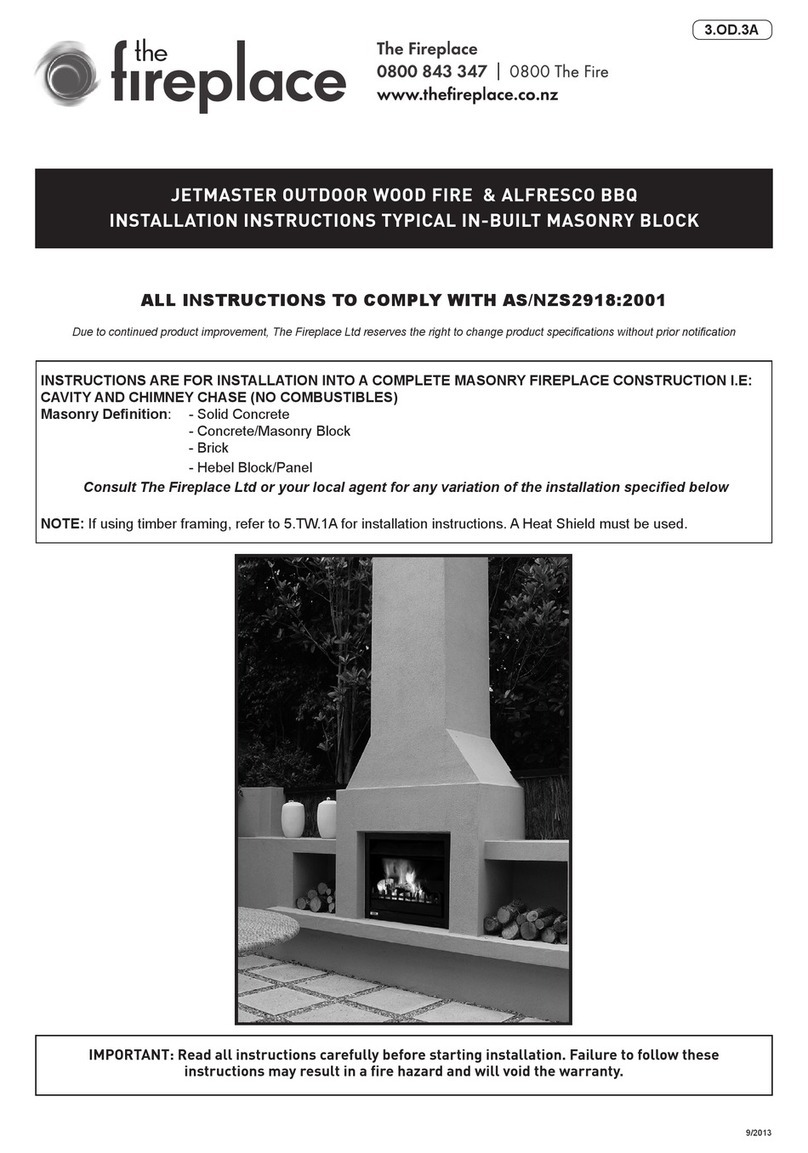
The Fireplace
The Fireplace JETMASTER 700 D installation instructions

Superior
Superior VRE4543EN Installation and operation instructions
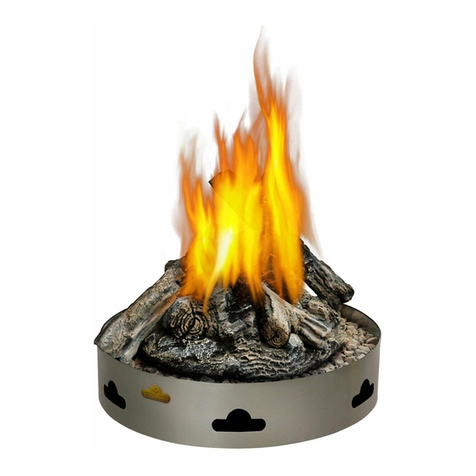
Napoleon
Napoleon PATIOFLAME GPFN Installation and operation instructions

Endless Summer
Endless Summer Dakota GAD19101ES owner's manual

Vermont Castings
Vermont Castings ODGSR36A Homeowner's installation and operating manual

FEUERHAND
FEUERHAND PYRON user manual

